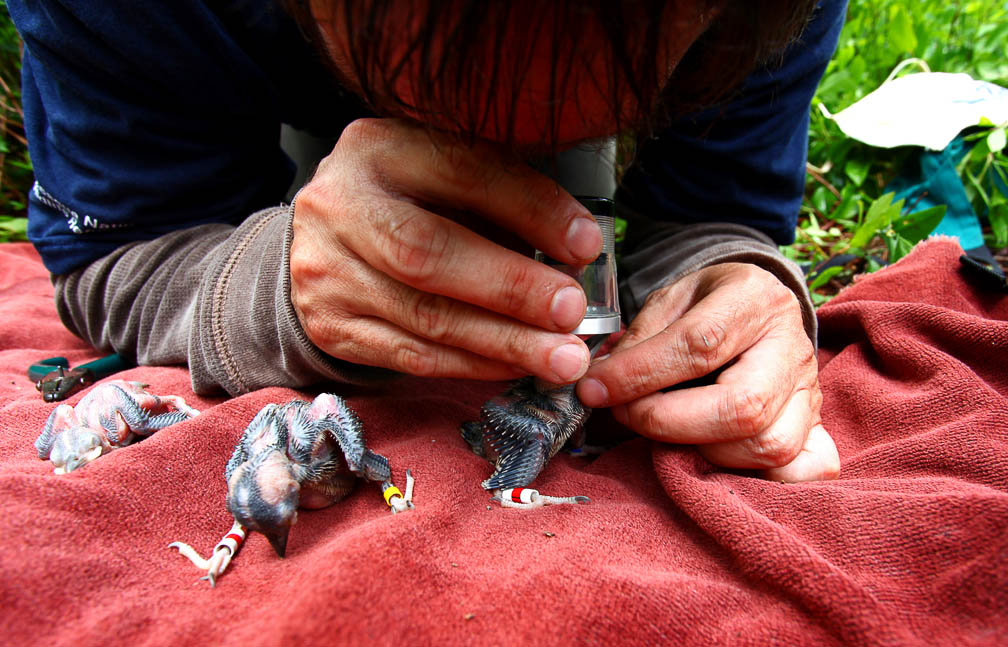Impacts of sea level rise on marsh birds
Friend & Conservation Partner, George Kinter: World traveler, birder & book collector
January 14, 2009
2009 Red-cockaded Woodpecker record breeding season
May 2, 2009
Written by Michael Wilson & Bryan Watts
May 1, 2009

Patches of salt marsh like these in the Chincoteague Bay that do not have regular sources of sediment will not be able to keep pace with rising sea level and will disappear with continued sea-level rise. Photo by Bryan Watts.
If realized, projected changes in the level of the world’s oceans will have profound consequences on the biological and social systems of the world. The earth’s sea-levels are forecasted to rise 0.5-2 meters before the end of the century. This global sea change will consume dry land, reshape our coastlines, and reconfigure our wetlands. It will also pose new limits on biological production and money economies that are tied to the near-shore environment. Understanding the impact from these dramatic changes is a necessary first step toward taking appropriate action.
Salt marshes are an integral part of the living coastline. They are the most productive ecosystems on earth and a dominant component of the world’s estuaries. The border they form between the ocean and the uplands is vital for filtering sediments from the upland and protecting the land from storms. However, their low position on the landscape also predisposes salt marshes to be the first landform consumed by rising seas. In many areas, large portions of marshes are already being submerged because the sea is rising faster than marshes can accumulate sediments to maintain elevation. Consequently, salt marshes that are not keeping pace with water levels have only two potential tracks for the future: 1) migrate over the uplands, or 2) become submerged.
Salt marshes are a critical habitat for a broad community of breeding birds. Virginia and Maryland supports nearly 30 % of the salt marsh cover along the Atlantic coast and 60 % of salt marsh cover north of the Carolinas. Because of this concentration of habitat, this region also supports a large portion of the continental population of several bird species. Sea-level in the Chesapeake Bay is already rising 2 times faster than the global average and the barrier islands of Maryland and Virginia’s eastern shore are quickly vanishing under rising waters. Taken together, these patterns suggest that projected patterns of sea-level may result in catastrophic impacts to bird populations in the Chesapeake Bay region with broader continental-scale implications.
We used species-specific information on mid-Atlantic bird species from the Center for Conservation Biology data library and a GIS simulation of land cover change (generated by the Sea Level Affecting Marshes Model SLAMM produced by Patty Glick, Jonathan Clough, and Brad Nunley for the National Wildlife Federation) to project changes in breeding populations and distribution under different sea-level rise scenarios. Values of bird density and marsh incidence rates were extrapolated over marsh availability in 25 year iterations through the year 2100.
The results of this forecast revealed a grim outlook for marsh birds. Species such as the clapper rail, virginia rail, willet, seaside sparrow, and marsh wren will experience population declines of nearly 80% if sea-levels rise 1-2 meters by the year 2100. This rise in sea-level equates to an annual increase of 10-20 mm/yr. For comparison, the current observed rate of sea-level rise in the Chesapeake Bay is 3-4 mm/yr but expected to double over this century. Sea-level rise will be particularly damaging to species that rely solely on the irregularly flooded, high marsh. High marsh species such as the black rail, saltmarsh sparrow, and henslow’s sparrow are already at risk of extirpation from the region. Climate change may have sealed their final destiny because many of the known breeding sites of these three species were obliterated in the simulation by rising waters.
The limiting factors that climate change imposes on species’ distribution and viability will pose the greatest challenges for conservation planning. The obvious issues that society must deal with are whether these limits are inevitable or to some extent under management control. One obvious action that society can take is to curb shoreline development that prevents marshes from migrating into the uplands with rising sea-levels. The armoring of shorelines that follows the creation of urban areas or flood/erosion control structures act as hard barriers that eventually squeeze marshes out of existence.
Figures 1 – 3:
The fate of marsh bird populations to rising sea-level and associated marsh loss.

Figure 1: Projected population decline of seaside sparrows, based on sea-level rise predictions. Graph by the Center for Conservation Biology.

Figure 2: Projected population decline of clapper rails, based on sea-level rise predictions. Graph by the Center for Conservation Biology.

Figure 3: Projected population decline of Virginia rails, based on sea-level rise predictions. Graph by the Center for Conservation Biology.
Project sponsored by The Center for Conservation Biology (CCB).



